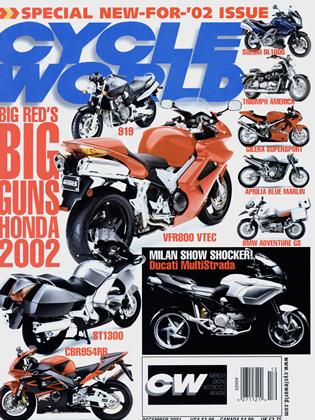125 SX
KTM 2002
It's all about power
IT’S NO SURPRISE TO ME THAT KTM NOW makes the fastest production 125.I raced for the Austrian factory in the early ’90s, and my 125 was worlds faster than any other eighth liter bike I rode until the end of the decade. I knew the stock bikes could make competitive power, it was just a matter of getting them set-up like the factory bikes, which simply used carefully assembled production motors. I know because I took mine apart to see all the tricks and there weren’t any. And when I kluged it back together, it was as slow as a stocker!
Now, the factory setup comes standard on the box-stock KTM 125 SX. In fact, the 2002 model’s porting specs and dimensions are said to be identical to those used by the 2001 U.S. race team. Changes include a new O-ring between the cylinder and head for better sealing and proper compression ratio, and needle bearings on the shift shaft that help ease the shifting load.
Neat touches include the hydraulic clutch, whose consistent action is especially appreciated on a 125; the adjustable top triple-clamp, whose four-position bar mountings should make all sizes of riders happy; and the large-diameter tapered handlebar.
Right off idle, the KTM has real torque, which is strange for a 125, and this feeling continues all the way through a long pull of power. The SX runs more like a 150 than a 125, but will shriek its guts out on top to provide that last smidgen of power that every 125 rider desires. This prompted one of our test riders, who’d taken a few years off from riding 125s, to ask, “Why am I riding a 250? I jumped everything easy on the KTM and it feels 40 pounds lighter than my bike (a Honda CR250).”
Compared to the rest of the 125cc class, there may be spots where the Yamaha, Honda or Kawasaki engines nudge ahead of the KTM’s for a second, but only the Suzuki RM 125 can match it for wealth and breadth of power.
Handling and suspension are the areas that traditionally have held back the 125 SX. The PDS linkage-less rear suspension is known to have a hard time coping on light bikes.
Getting compliance for small bumps while keeping the stiffness needed to avoid bottoming and retain steering precision is usually the work of a link. So, typically, the KTM’s rear suspension has been stiff, and this year it is just that, at least in the initial part of its stroke. And the fork is calibrated to match.
But the suspension doesn’t seem as harsh as in years past for two reasons: First, KTM made it much more compliant with better shock valving. And second, the competition’s suspension is getting stiffer, with more Pro-level settings, so the SX doesn’t stand out as much anymore. In that respect, KTM could lay claim to being ahead of its time.
Watching the KTM race team run at the front of the pack-and very nearly win the championship-in this year’s 125cc outdoor nationals shows what these bikes are capable of doing. The once-oddball European bikes are becoming more of a regular sight at MX tracks, and for good reason: They’re making the small-bore class more than a four-way fight. Riding the 2002-model 125 SX proves that it is more than just a player in the class. It may even be the leader.
Jimmy Lewis
 View Full Issue
View Full Issue
More From This Issue
-
 Up Front
Up FrontWind Machine
December 2001 By David Edwards -
 Leanings
LeaningsCanadian Ducks
December 2001 By Peter Egan -
 TDC
TDCAnyone Can Do It
December 2001 By Kevin Cameron -
 Departments
DepartmentsHotshots
December 2001 -
 Roundup
RoundupMerger Mayhem In Japan
December 2001 By Kevin Cameron -
 Roundup
RoundupIs Saddleback Back?
December 2001 By Brian Catterson




